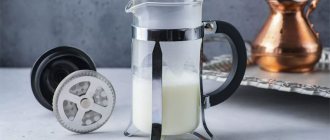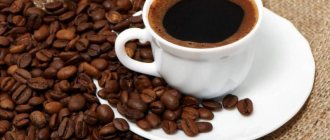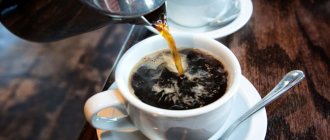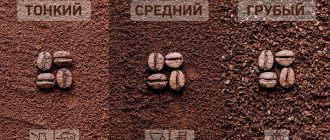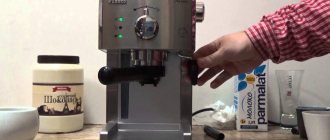WATER
The quality of water is very important for making good coffee - after all, the majority of the drink is water. Bad water can seriously ruin the taste of the drink. Regular tap water is not suitable for making truly high-quality coffee (unless you have a good water filter), so it is best to use fresh bottled water. Avoid using softened water - calcium and magnesium salts have been removed from such water, which negatively affects the taste and aroma of coffee. For the same reason, distilled water cannot be used, because it does not contain salts and minerals. Remember to always use fresh water - stagnant water quickly breeds microorganisms and bacteria that negatively affect the taste of coffee.
How to choose a Turk
Turka is a sacred object. It is there that the process of transforming ground coffee beans and water into a drink beloved by millions takes place, so the debate about which Turk to choose is eternal. We'll tell you how to find a Turk with harmony of form and content.
Geometry rules
An important indicator is the ratio of the sizes of the base and neck. The narrowing should be noticeable so that the diameter of the neck is at least one third smaller. This is not a whim, but an understandable requirement - essential oils will not be able to evaporate from the narrowed throat of a Turk. An indicator that you are doing everything correctly will always be a fragrant foam, which plays the role of a kind of plug that keeps freshly prepared coffee from contact with air. And if the neck is too wide or there is none at all, then, alas, you won’t get wonderful coffee foam. The coffee will only boil uncontrollably and overcook.
It is better to select the volume of the Turkish coffee for the portion that you drink every morning, for example, 150-200 ml, because in a larger container the portion of coffee you need will also not feel very comfortable and will not form foam.
Technologies and materials
There are many materials from which Turks are made. Freedom of choice allows you to choose it according to its functionality, aesthetics, wallet, or even according to your horoscope.
Copper Turks came to us from the countries of the East, which gave their name to the method of preparing coffee. Copper conducts heat well, but does not accumulate it, and gets along well with a gas stove. It is important that the copper is internally treated with silver or food-grade tin, since it is neutral and does not enter into chemical reactions with food. It is very good if the copper pot is forged and has a thick bottom; the thicker it is, the more uniform the heating of the container.
Clay and ceramics are quite inert; they heat up slowly and take a long time to cool down. These materials have a more porous structure. During the heating process, the drink is enriched with oxygen, giving the drink all its flavor. The coffee is cooked even after the Turk has been removed from the heat; this must be taken into account when preparing.
All coffee utensils of the ceramic group are fragile, they should not be subjected to sudden changes in temperature, and they should only be cooked on a gas stove using a divider; an electric stove is more suitable for this group of Turks.
Among the exotic ones, it is worth highlighting quartz cezves. As experience has shown, they cope well with their role, they are functional, but at the same time, of course, they fight, this is a minus.
What not to buy
We do not recommend purchasing an aluminum Turk. Aluminum is considered unsuitable for making coffee; when heated, it reacts, changes the taste of coffee, and does not compliment the drink.
What do we cook in?
We recommend having two Turks at home: one small one for yourself every morning, for example, 100 ml. And another one – two cups larger, 200-250 ml, in order to meet friends with dignity and share freshly prepared coffee with them. It’s great if your Turks are made from different materials, so you will learn in practice all the features of making coffee.
GRINDING AND BREWING TIME
Grinding the beans is a key factor when making coffee. The finer the grind, the greater the surface area of the coffee in contact with the hot water. You often hear that the finer the coffee grind, the better, but this opinion is wrong - too fine a grind can ruin the drink. The point is that we want to extract maximum flavor and aroma from the beans - nothing more. If the grind is too fine or the coffee has been in contact with water for too long, the drink will turn out bitter. On the other hand, grinding too coarsely and/or insufficient brewing time prevents all the flavor nuances from being extracted from the coffee. The trick is to choose the right grind size and ideal brew time for each brewing method (we'll cover these key points separately in our respective articles).
Here is the answer to the question “I bought a coffee machine, but it makes cold coffee, what should I do?”
Increase the temperature of the drink in the settings! But usually, if such a question is asked, then the temperature in the settings is already at the maximum.
First, let me give myself some theoretical introduction. You need to soberly evaluate what you are brewing or are going to brew on a coffee machine/coffee maker. All grain machines and carob coffee makers are espresso machines and brew espresso. According to all standards, espresso is brewed in the brewing chamber/group at approximately 90-95 degrees. Water at this temperature should be supplied to the ground coffee. As a rule, the basket/charger, coffee, as well as the further coffee path to the dispensing spout have a much lower temperature than 90 degrees. In a carob coffee maker, it’s a stone’s throw from the basket of coffee to the cup; in grain machines, they can be separated by another 10-30 centimeters of tubes and a plastic dispenser in the dispensing spout, which also take the temperature.
Contrary to the recommendations, almost no one ever warms up the cup, as well as the carob with filter for carob coffee makers, that is, they are at room temperature, about 25 degrees. Canonical espresso is a maximum of 40 ml, and what is the weight of your cup? Even without deep knowledge of physics, it is obvious that coffee in a cup cannot be 90 degrees in principle, and it is difficult for it to be at least 80. That is why the Italians use preheated thick-walled ceramic cups for espresso. From a professional carob coffee machine with constant heating and preheating of the brewing group, you can serve 80 degrees or more, but I haven’t seen it from a machine.
This introduction was for those who unexpectedly discovered that coffee from a coffee machine is colder than they are used to drinking, brewing it, for example, with boiling water just in a cup (instant, hello), or cooking it in a Turk, geyser (the technologies themselves almost bring coffee to a boil and it can be told there is no place to cool before it gets into the cup). Yes, carob coffee makers can serve coffee hotter than it comes from automatic coffee machines, you need to accept this fact.
As for the vending machines, if all preparatory procedures are followed (idling, warming up the cup), they all dispense approximately the same drink in temperature, the differences are minor. It is almost impossible to make final measurements and comparisons, because you need to laboratory adjust the heating of all parts of the coffee machines to the same state, use one cup heated to a certain temperature, use the same grain with a similar grind and set to the same strength, because even these parameters influence on the final temperature - the coarser the grind and the lower the strength, the higher the temperature of the drink.
The only somewhat tangible guidelines that I can give are:
- Delonghi coffee machines at the maximum temperature setting (almost all coffee machines have in the drink settings menu) produce espresso a little hotter than other brands.
- Melitta and Jura coffee machines produce espresso in a cup one iota colder than all others.
- The first cup after turning on the coffee machine or being idle for at least half an hour will always be colder than the subsequent ones, for all machines. To level this out, I recommend doing an idle spill—a “quick rinse of the coffee tract.” Not everyone has this function, but some, such as most Delongis, even have it on a separate key on the control panel.
If the numbers in the photographs below plunge you into deep sadness, then you need to look for a carob coffee maker - even at home you can get 80-degree espresso without much effort. Plus, on the carob, if you really need it, you can force the boiler to warm up to a higher temperature by turning on the steam preparation for five seconds.
So, for illustration, below are photographs of my temperature measurements of the first and second after turning on a 40 ml espresso shot at medium strength and average set temperature on Delonghi ECAM 22.110, Philips HD 8649, Jura Ena Micro 90 and Melitta Varianza CSP coffee machines. The cup was not warmed up, it was +/- room temperature, the idle pouring was not deliberately done - that is, this is a typical situation for most coffee lovers. Taking into account the fact that almost all models of the same brand use the same heaters, we can say that the situation is typical for the entire product line of each manufacturer. In addition, Melitta’s thermoblock repeats a similar unit in Nivon and Mili. Well, it’s clear that the pyrometer also has its own error of a couple of degrees.
First shot of espresso after switching on, cup not warmed up
Second shot after switching on. After the initial warm-up, the Delonghi, as a rule, always produces a little hotter than its competitors
If you are interested in the temperature of cappuccino and frothed milk, the measurements are given here.
There are also comments on the differences in milk from different brands. Publication date: 04/21/2020.
Your opinion is important to me. Please rate the material: (Total ratings: 22. Average: 4.59 )
What else can you add
Spices and seasonings
To make each cup of drink unique, add spices. Experienced coffee lovers advise buying coffee additives in their entirety and grinding them before preparing. This way the seasonings will retain their original taste.
To add flavor add:
- cardamom;
- cinnamon;
- anise;
- ginger;
- nutmeg;
- black pepper;
- caraway;
- cloves;
- star anise;
- salt;
- Bay leaf;
- vanilla.
Find out more in the article “Spices and Seasonings for Coffee.”
Toppings
To give your coffee an original taste, add nut, berry-fruit, chocolate or caramel, and vanilla syrups. And also with ginger, cinnamon or cloves. Finish the composition with chocolate or confectionery crumbs or wafer topping. Garnish the top of the drink with them.
Continuing the topic, we recommend that you read the article “About coffee topping: what is it?”
Coconut milk
The additive gives a delicate creamy taste and an unforgettable aroma. It is used to draw on milk foam with a wooden stick.
Read more in the article “Can I add coconut milk to coffee?”
Salt
To neutralize the bitterness, add a pinch of salt to the drink. It influences the final aroma, releases a pleasant aroma and enhances the sweetness. Add seasoning before steeping the grains.
More details about the nuances of preparation are described in the article “How to make coffee with salt.”
Cream
Add for a delicate taste and aesthetically pleasing appearance. If you have vanilla, cinnamon, cocoa powder or flavored syrup on hand, use those too.
Read more about the drink in the article “What you need to know about coffee with cream.”
Honey
Coffee with honey is an unusual combination. But this set has a tonic property and gives vigor on a rainy, sad day.
Thanks to the variety of honey varieties, you can get tart, aromatic, sweet, savory or bitter coffee. For variety, you can add a thin strip of garlic.
Find out more in the article “What you need to know about coffee with honey.”
Reposting will help you track reviews of your post. Special thanks for the like.
Previous How to brewHow to brew coffee with foam in a Turk at home Next How to brewHow to brew instant coffee correctly
Selection and preparation of coffee beans
The method of harvesting coffee beans and the type of tree from which the harvest was harvested largely determine the taste of the drink. Arabica beans are distinguished by their versatility in taste and aroma. Among the types of Arabica, there are beans with the aroma of fruit (Sumatra Lintong Coffee), chocolate (Maragogipe), as well as with chocolate-nutty (Coffee Yauco Selecto) and creamy tones (Burbon).
Robusta fruits contain more caffeine and give the drink a more bitter and tart taste. Often the packaging contains a mixture of Arabica and Robusta, which reduces the cost of the final product.
The astringency of coffee also depends on the degree of roasting of the beans: the darker the color of the beans, the less characteristic bitterness will be felt in the drink. Intensive roasting until drops of oil appear on the surface of the grain (Italian coffee roasting) makes the taste almost empty, and the smell becomes scorched.
Before cooking, or rather brewing, the grains, they are ground in a coffee grinder or with a pestle in a porcelain mortar to a medium or small particle size. The finished mass has a powdery consistency.
It is recommended to grind the beans immediately before brewing coffee to prevent aromatic compounds from evaporating.
We make coffee. How to brew coffee in Turkish
So, having professionally approached the most important stages of preparation, you should also carefully follow the technology of the cooking process itself. The result will exceed your expectations!
- The coffee-water ratio is very important, the golden ratio is 1 g per 10 ml.
- The temperature of the water you fill in the Turk is room temperature.
- We brew coffee in a Turk over the lowest heat, this will reveal its bouquet to the maximum.
- If we cook on a gas stove, it is very appropriate to use a copper pot. Turks of the entire ceramic group are used only with a divider.
- An electric stove is more friendly to clay and ceramics and does not require any additional devices.
- An induction hob requires a pot with ferromagnetic properties; the bottom should be attracted to a magnet.
Cooking time
The criterion that the coffee is about to be ready is the appearance of foam; it should curl inward. Just raising it once is enough; there is no need to boil it several times in order to make the foam more fluffy.
In a 200 ml Turk, coffee can be prepared in about 4-5 minutes. It doesn’t sit longer; the quality of the drink won’t improve, but it will add more bitterness and acidity.
Hot water extracts maximum flavor from the coffee
Obviously, you can't brew a cup of coffee without water, and good, clean water is the key to a great tasting cup. Water is an element in the brewing process that is fundamental in drawing out the flavor from your freshly ground coffee beans, which by the way is called “extraction” in the coffee world.
Just like with food, if you burn your coffee, you'll end up with a bitter-tasting product. Coffee is no different, you get too hot water and you risk leaving your coffee bitter along with over-extraction. On the other hand, if your water is too cold, you risk getting weak-tasting coffee that also suffers from under-extraction.
Yes, before you all go down to the comments section to tell me that there are methods that use cold water that I know of and that is a completely different way to brew coffee. Let me tell you that in this article I’m talking about brewing hot coffee, not cold coffee.
No boiling water
No one usually stands on ceremony with instant coffee. They threw it into a cup, added sugar and poured water from a just boiled kettle. The last point is where the key mistake lies. It is strictly forbidden to pour boiling water over instant coffee. The point is the taste, which changes for the worse when exposed to water temperatures above 90 degrees. And there is a completely reasonable explanation for this.
The difference between ground and instant coffee can be very easily felt even by people who are the most distant from the coffee topic. Yes, we are talking about those very specific notes of an instant drink, which many describe as “chemical”. This is the taste of artificial flavors and other delights generously added during the production process. And when exposed to boiling water, this taste intensifies, turning from coffee into an obsessive chemical taste. Hence the first and most important advice - no boiling water, brew only with hot water at a temperature of 85-90 degrees. Take your time, open the lid of the boiled kettle and leave it for a couple of minutes - it will take a little more time, but the taste of the finished drink will be much more pleasant.
How to choose delicious Turkish coffee
Having decided on the Turk itself, we move directly to choosing coffee for it. The path of a barista, even a home one, requires knowledge about the types of roasting and degree of grinding, as well as general principles for choosing quality grains.
Do you want to know what kind of Turkish coffee we choose? Take a look at our carefully selected and time-tested selection of varieties.
What roast is suitable for Turkish
We recommend starting your search for the perfect Arabica for Turkish coffee with dark roast coffee. If possible, evaluate the grains visually before purchasing. They should not be too dark (grains that look like coals - do not take them), matte, without protruding oil and more or less uniform in tone and size.
If you're in the mood to experiment, consider light roast coffee. When brewed in a Turk, this roast will perfectly reveal itself in your cup with bright sourness and a variety of shades of berries, flowers and fruits.
How to find coffee beans to suit your taste (and where it’s profitable to buy it)
Our invaluable advice and a complete guide to choosing high-quality coffee beans, which will be very useful to you, especially if, in addition to brewing in a Turk, you also use other preparation methods.
Warmed milk only
Especially for lovers of coffee with milk, it is worth mentioning one more important nuance. It is advisable to add preheated milk to your coffee. This milk, unlike cold milk, does not interrupt, but complements the taste and aroma of instant coffee. Naturally, for the better. There are clearly not many instant coffee lovers who want to tinker with heating milk, but at least try it. What if you like it?
Subscribe to our Yandex.Zen so as not to miss cool articles
Telegram channel with the best discounts and prompt news updates
Geekville on VKontakte - our group with all the latest content

